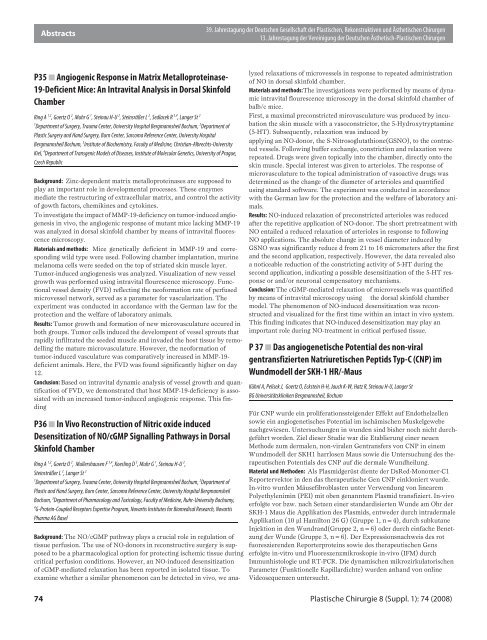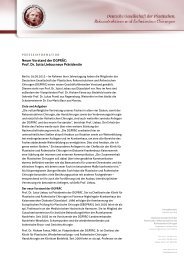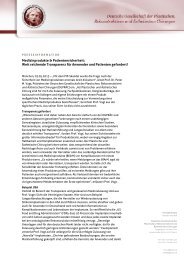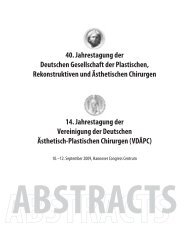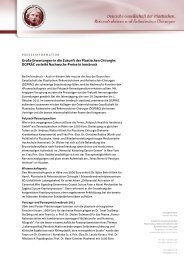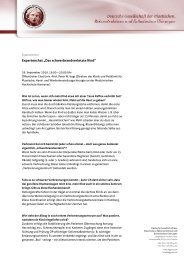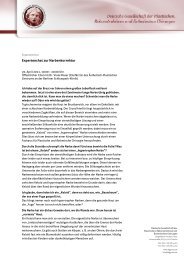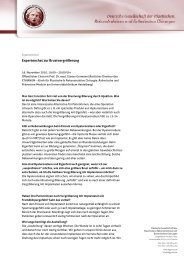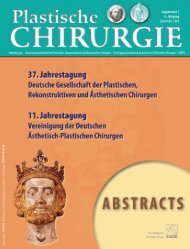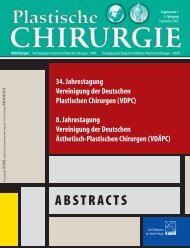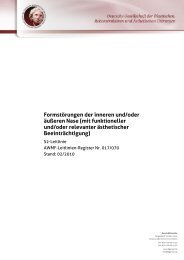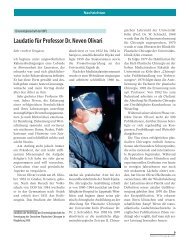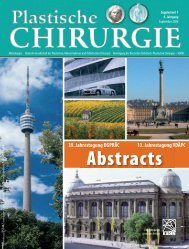Abstracts - DGPRÄC
Abstracts - DGPRÄC
Abstracts - DGPRÄC
Erfolgreiche ePaper selbst erstellen
Machen Sie aus Ihren PDF Publikationen ein blätterbares Flipbook mit unserer einzigartigen Google optimierten e-Paper Software.
<strong>Abstracts</strong><br />
P35 � Angiogenic Response in Matrix Metalloproteinase-<br />
19-Deficient Mice: An Intravital Analysis in Dorsal Skinfold<br />
Chamber<br />
Ring A 1,2 , Goertz O 2 , Muhr G 1 , Steinau H-U 2 , Steinsräßer L 2 , Sedlacek R 3,4 , Langer St 2<br />
1 Department of Surgery, Trauma Center, University Hospital Bergmannsheil Bochum, 2 Department of<br />
Plastic Surgery and Hand Surgery, Burn Center, Sarcoma Reference Center, University Hospital<br />
Bergmannsheil Bochum, 3 Institute of Biochemistry, Faculty of Medicine, Christian-Albrechts-University<br />
Kiel, 4 Department of Transgenic Models of Diseases, Institute of Molecular Genetics, University of Prague,<br />
Czech Republic<br />
Background: Zinc-dependent matrix metalloproteinases are supposed to<br />
play an important role in developmental processes. These enzymes<br />
mediate the restructuring of extracellular matrix, and control the activity<br />
of gowth factors, chemikines and cytokines.<br />
To investigate the impact of MMP-19-deficiency on tumor-induced angiogenesis<br />
in vivo, the angiogenic response of mutant mice lacking MMP-19<br />
was analyzed in dorsal skinfold chamber by means of intravital fluorescence<br />
microscopy.<br />
Materials and methods: Mice genetically deficient in MMP-19 and corresponding<br />
wild type were used. Following chamber implantation, murine<br />
melanoma cells were seeded on the top of striated skin muscle layer.<br />
Tumor-induced angiogenesis was analyzed. Visualization of new vessel<br />
growth was performed using intravital flourescence microscopy. Functional<br />
vessel density (FVD) reflecting the neoformation rate of perfused<br />
microvessel network, served as a parameter for vascularization. The<br />
experiment was conducted in accordance with the German law for the<br />
protection and the welfare of laboratory animals.<br />
Results: Tumor growth and formation of new microvasculature occured in<br />
both groups. Tumor cells induced the develompent of vessel sprouts that<br />
rapidly infiltrated the seeded muscle and invaded the host tissue by remodelling<br />
the mature microvasculature. However, the neoformation of<br />
tumor-induced vasculature was comparatively increased in MMP-19deficient<br />
animals. Here, the FVD was found significantly higher on day<br />
12.<br />
Conclusion: Based on intravital dynamic analysis of vessel growth and quantification<br />
of FVD, we demonstrated that host MMP-19-deficiency is assosiated<br />
with an increased tumor-induced angiogenic response. This finding<br />
P36 � In Vivo Reconstruction of Nitric oxide induced<br />
Desensitization of NO/cGMP Signalling Pathways in Dorsal<br />
Skinfold Chamber<br />
Ring A 1,2 , Goertz O 2 , Mullershausen F 3,4 , Koesling D 3 , Muhr G 1 , Steinau H-U 2 ,<br />
Steinsträßer L 2 , Langer St 2<br />
1 2 Department of Surgery, Trauma Center, University Hospital Bergmannsheil Bochum, Department of<br />
Plastic and Hand Surgery, Burn Center, Sarcoma Reference Center, University Hospital Bergmannsheil<br />
Bochum, 3Department of Pharmacology and Toxicology, Faculty of Medicine, Ruhr-University Bochumy,<br />
4G-Protein-Coupled Receptors Expertise Program, Novartis Institutes for Biomedical Research, Novartis<br />
Pharma AG Basel<br />
Background: The NO/cGMP pathway plays a crucial role in regulation of<br />
tissue perfusion. The use of NO-donors in reconstructive surgery is supposed<br />
to be a pharmacological option for protecting ischemic tissue during<br />
critical perfusion conditions. However, an NO-induced desensitization<br />
of cGMP-mediated relaxation has been reported in isolated tissue. To<br />
examine whether a similar phenomenon can be detected in vivo, we ana-<br />
39. Jahrestagung der Deutschen Gesellschaft der Plastischen, Rekonstruktiven und Ästhetischen Chirurgen<br />
13. Jahrestagung der Vereinigung der Deutschen Ästhetisch-Plastischen Chirurgen<br />
lyzed relaxations of microvessels in response to repeated administration<br />
of NO in dorsal skinfold chamber.<br />
Materials and methods: The investigations were performed by means of dynamic<br />
intravital flourescence microscopy in the dorsal skinfold chamber of<br />
balb/c mice.<br />
First, a maximal preconstricted mirovasculature was produced by incubation<br />
the skin muscle with a vasoconstrictor, the 5-Hydroxytryptamine<br />
(5-HT). Subsequently, relaxation was induced by<br />
applying an NO-donor, the S-Nitrosoglutathione(GSNO), to the contracted<br />
vessels. Following buffer exchange, constriction and relaxation were<br />
repeated. Drugs were given topically into the chamber, directly onto the<br />
skin muscle. Special interest was given to arterioles. The response of<br />
microvasculature to the topical administration of vasoactive drugs was<br />
determined as the change of the diameter of arterioles and quantified<br />
using standard software. The experiment was conducted in accordance<br />
with the German law for the protection and the welfare of laboratory animals.<br />
Results: NO-induced relaxation of preconstricted arterioles was reduced<br />
after the repetitive application of NO-donor. The short pretreatment with<br />
NO entailed a reduced relaxation of arterioles in response to following<br />
NO applications. The absolute change in vessel diameter induced by<br />
GSNO was significantly reduce d from 21 to 16 micrometers after the first<br />
and the second application, respectively. However, the data revealed also<br />
a noticeable reduction of the constricting activity of 5-HT during the<br />
second application, indicating a possible desensitization of the 5-HT response<br />
or and/or neuronal cempensatory mechanisms.<br />
Conclusion: The cGMP-mediated relaxation of microvessels was quantified<br />
by means of intravital microscopy using the dorsal skinfold chamber<br />
model. The phenomenon of NO-induced desensitization was reconstructed<br />
and visualized for the first time within an intact in vivo system.<br />
This finding indicates that NO-induced desensitization may play an<br />
important role during NO-treatment in critical perfused tissue.<br />
P 37 � Das angiogenetische Potential des non-viral<br />
gentransfizierten Natriuretischen Peptids Typ-C (CNP) im<br />
Wundmodell der SKH-1 HR/-Maus<br />
Kühnl A, Pelisek J, Goertz O, Eckstein H-H, Jauch K-W, Hatz R, Steinau H-U, Langer St<br />
BG Universitätskliniken Bergmannsheil, Bochum<br />
Für CNP wurde ein proliferationssteigender Effekt auf Endothelzellen<br />
sowie ein angiogenetisches Potential im ischämischen Muskelgewebe<br />
nachgewiesen. Untersuchungen in wunden sind bisher noch nicht durchgeführt<br />
worden. Ziel dieser Studie war die Etablierung einer neuen<br />
Methode zum dermalen, non-viralen Gentransfers von CNP in einem<br />
Wundmodell der SKH1 harrlosen Maus sowie die Untersuchung des therapeutischen<br />
Potentials des CNP auf die dermale Wundheilung.<br />
Material und Methoden: Als Plasmidgerüst diente der DsRed-Monomer-C1<br />
Reportervektor in den das therapeutische Gen CNP einkloniert wurde.<br />
In-vitro wurden Mäusefibroblasten unter Verwendung von linearem<br />
Polyethylenimin (PEI) mit oben genanntem Plasmid transfiziert. In-vivo<br />
erfolgte vor bzw. nach Setzen einer standardisierten Wunde am Ohr der<br />
SKH-1 Maus die Applikation des Plasmids, entweder durch intradermale<br />
Applikation (10 µl Hamilton 26 G) (Gruppe 1, n=4), durch subkutane<br />
Injektion in den Wundrand (Gruppe 2, n=6) oder durch einfache Benetzung<br />
der Wunde (Gruppe 3, n=6). Der Expressionsnachweis des rot<br />
fuoreszierenden Reporterproteins sowie des therapeutischen Gens<br />
erfolgte in-vitro und Fluoreszenzmikroskopie in-vivo (IFM) durch<br />
Immunhistologie und RT-PCR. Die dynamischen mikrozirkulatorischen<br />
Parameter (Funktionelle Kapillardichte) wurden anhand von online<br />
Videosequenzen untersucht.<br />
74 Plastische Chirurgie 8 (Suppl. 1): 74 (2008)


